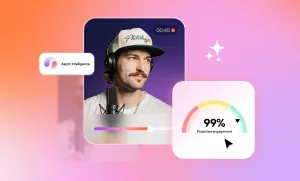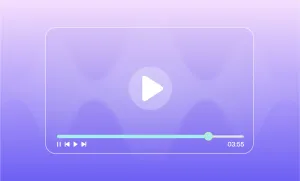Intuitive recording and editing software make it a breeze to create video podcasts that look professional and sound great. But there is still one challenge that comes up when creating content for a video podcast - what style should you use?
To help you navigate the styles that are trending in 2023, we’ve put together a list of four trendy video podcasting styles to try.
The On-Camera & Off-Camera Interview
The on-camera style pairs the host and guest together in one shot, while having a second camera that captures just the guest's reactions. It can help create a more intimate feeling between the two people involved, and helps bring out interesting and unique perspectives from both parties. The guest can also look directly at the camera and make eye contact with the audience.
In the off-camera interview style, the host and guest are separated by the camera, with one shot taking up the entire frame. The videographer asks questions or prompts the guest's responses, but the audience is not aware of this. After that, the videographer's voice is cut out, leaving only the guest's answers. This can be used to create a feeling of immediacy and urgency in your podcast, as well as engaging with your viewers.
To camera
- The speaker looks directly into the camera.
- There is an impression that the guest is speaking directly to the audience.
Off camera
- The speaker is only looking at the side of the camera.
- Despite the audience not being able to hear the questions, it seems like the guests are speaking to someone who is standing close to the camera.
- The perception of "eavesdropping" on a discussion gives it a more authentic and credible vibe.
- It is a classic documentary style.
The Direct-Address Interview
This method enables the interviewee to make direct eye contact with viewers from the center of the camera frame. The direct-address interview technique allows the speaker to convey his or her message clearly and effectively to the audience often by using the "interrogation" style or a homemade mirrored rig.
This interview style creates a genuine atmosphere where the audience will feel like they are in a one-to-one conversation with the interviewee. In direct-address interviews, interviewers ask more open-ended questions, allowing the speaker to give more creative responses. Additionally, this interview style allows for more detailed follow-up questions, which can give insight into the speaker’s thought process and experience.
The Cinematic Video Interview
The cinematic video interview is an increasingly popular method of capturing candid conversations between two people in an engaging and impactful way. This type of interview takes advantage of the visual and emotive potential of video, allowing viewers to connect with the content on a deeper level than they would with conventional audio-only recordings. Interviews filmed in this style are often used to showcase someone's personal story or provide a behind-the-scenes look at an organization or event.
The cinematic video interview typically consists of two or three cameras set up in a room, capturing the conversation between the interviewee and the interviewer. The cameras are often arranged in a triangular configuration, which allows for multiple angles to be used to capture the conversation.
The cinematic video interview is an ideal way to capture the spirit of a person’s story, showcase their expertise, and engage viewers in a captivating way. Furthermore, this style of interview has become increasingly popular with businesses, as it allows them to create compelling content.
How to Record a Video Interview With Podcastle.ai
If you want to record a video podcast with your co-host or guest in the same space as you, attach a sound card OR several USB microphones to each speaker’s device, and Podcastle will record each speaker onto different tracks automatically! This way, the sound is smooth and clear without echoes and other audio issues.
Simply turn ON the Input setup when recording inside of a project, connect your microphones to your computer through a USB and/or sound card, and start recording.
What Are the 3 Techniques for a Successful Video Interview?
Directive-question video interviewing involves asking specific questions regarding a chosen subject. It is ideal for generating viewpoints and ideas from professionals. It can also be applied to situations like street interviews, where the variety of responses to the same subject from several participants piques curiosity.
Non-directive questions are designed to allow candidates to express their thoughts and feelings openly without any pressure or judgment. They are used to draw out the candidate's experiences and opinions on a specific topic, allowing the interviewer to gain an understanding of the individual's skills, abilities, and motivations. Non-directive questions are effective because they allow the candidate to think before they answer and encourage the candidate to elaborate
Semi-structured interviews involve a combination of open-ended and closed-ended questions that allow the researcher to obtain detailed and in-depth information from the respondent. Semi-structured interviews enable the researcher to explore topics of interest while also allowing the respondent to provide additional information or elaborate on topics as desired. When crafting semi-structured interview questions, it is important to ensure that the questions are well-constructed, clear, and open-ended enough to allow the respondent to offer their insights.
Conclusion
When it comes to deciding which style is best for your video podcast, defer to your audience's interests. Consider what kind of content they would like to see and how you can best communicate it. Different styles work for different types of podcasts, so experiment to find one that fits your audience's needs. Ultimately, the goal is to engage viewers with useful information presented in an entertaining way. Good luck!








